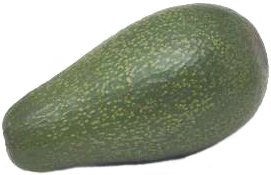

Avocado
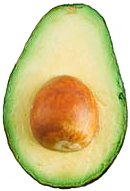
Persea (Name used by Theophrastus for an Egyptian tree.) Lauraceae. 150 species of evergreen trees or shrubs. Leaves entire, alternate and pinnately veined. Flowers bisexual or unisexual, inconspicuous, yellow-green, in axillary or terminal panicles; perianth tube short, lobes 6, subequal or with outer 3 smaller; stamens 9 in male or perfect flowers; ovary sessile; style slender; stigma small, flattened. Fruit a berry or drupe, ellipsoid to pyriform. Tropical and subtropical America, Macaronesia, SE Asia. CultivationPersea Americana, the avocado, is widely cultivated for its fruit. The three races, Mexican (M), Guatemalan (G), and West Indian (W), correspond to the subtropical, semitropical and tropical climate respectively. Similarly, the oil content of the fruit declines from high (over 20%) to low (under 10%). The fruit contains 3-30% oil of the same consistency as olive oil. The sugar content is low, but there is much vitamin A and moderate amounts of vitamins B and C. The oil can also be used for cosmetic purposes. The major avocado producers are Mexico and the US; the fruit is also exported to Europe from Israel, South Africa and Kenya. Each avocado flower opens twice: the pistil (female part) ripens first; it then closes to open many hours later in the male stage. The duration of closing also differs: in group A it takes more than 24 hours, from morning to next afternoon; in group B it closes for less than 24 hours, from afternoon to the following morning. This renders self-pollination unlikely, but not impossible; cold or rain may upset the rhythm. However, single trees – with no pollinator nearby – seldom bear fruit. In every orchard at least two clones should be planted. The tree is large and the branches are elongated from terminal buds. There are two flushes per season. Lateral buds are easily shed, and pruning must therefore be handled carefully. A seed can germinate in about a month, but it takes only 17 days with the seed coat removed. Seedling trees bloom after 5-7 years; grafted trees start flowering in the third year. Depending on the race, avocado thrives best in climates ranging from subtropical to fully tropical. Avocado grows on all kinds of soils, if well-drained to at least 1m below the surface. The tree suffers from saline conditions, but West Indian rootstocks are fairly tolerant. As the branches are brittle, shelterbelts may be needed as protection against strong winds. 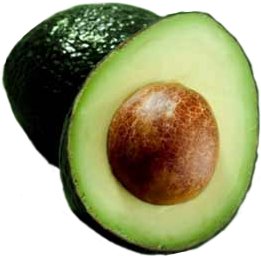
‘Fuerte’, a Mexican x Guatemalan (M x G) hybrid, is the most popular cultivar. Its first is shiny green and pear-shaped, weighs around 300g and contains about 22% oil; the flower type is B. The tree is fairly cold resistant and has a horizontal habit of growth ‘Hass’ (G), group A, is self-fertile and has a warty fruit that turns dark purple when mature. Other cultivars grown in the subtropics are ‘Zutano’ (M x G, group A), ‘Bacon’ (M x G, group B) and ‘Nabal’ (G, group A). Florida cultivars are better suited to warmer climates. The most important cultivars, ranked from early to late, are: ‘Pollock’ (W, group B), ‘Simmonds’ (W, group A), ‘Tonnage’ (G, group B), ‘Monroe’ (G x W, group A). ‘Lula’ (late, G x W, group A) produces well in Texas. There are many others. A good avocado cultivar must have a good and regular yield of high-quality fruit of medium weight (about 400g) and small seeds in a well-filled cavity. The fruit should hold well on the tree and have a good storage life. A small-sized or medium-sized tree with spreading habit is preferred. At least three cultivars with successive harvesting seasons are desirable. The West Indian cultivar ‘Waldin’ is commonly used as a rootstock in Florida. Two ‘Duke’ (M) selections were found to be good rootstocks. Their rooted cuttings performed better than the seedlings. Later selections are G6 and G22. Seedling trees are commonly grown in the tropics, but cultivars grafted on seedling rootstock are preferable. To avoid root rot in the nursery, seed must not be gathered from fallen fruit. Instead, picked fruit from selected trees, free from sunblotch virus, should be used. The seeds are disinfected in water of 50°C for 30 minutes, cooled and air-dried. Seedcoats, tops and bottoms are cut away and the seeds are sown, broad side down, at 30 x 60cm; a layer of sand, no more than 1cm thick, should cover the top. If good seed is scarce, it may be split lengthwise in 4-6 parts; they will germinate if a piece of the embryo is present. Alternatively, seeds are sown in polythene bags filled with perlite. It takes about four weeks for a seed to germinate. Two weeks later terminal scions of healthy trees are cleft-grafted or side-grafted on to the seedling stocks. Some five weeks later, transplantation to bigger containers takes place. However, in most tropical countries 4-month old seedlings are used for side-grafting or veneer-grafting. It is important to protect the roots of bagged plants against excessive heat. Plant in holes deep and wide enough to accommodate the roots, spaced from 5 x 5 to 12 x 12m. A cover crop of vegetables may be grown between the trees, but tomato, eggplant and other Solanaceae must be excluded because of the fungus disease they carry. To ensure adequate pollination, 2-4 rows of group A cultivar should alternate with 2-4 rows of group B cultivar. Beehives must be placed in the orchard when the trees are in bloom. Dead trees must be replaced immediately. 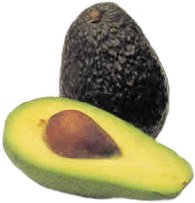
As mechanical cultivation is harmful to the shallow root system of avocado, it is better to plant to cover the crop in the humid tropics and to use herbicides in drier areas. Where rainfall falls below Ep for more than two months, then trees must be irrigated. Flooding is the cheapest method but it promotes root rot; sprinkling or drip irrigation are preferred. Experiments in Israel show that 60% of class A pan evaporation is sufficient. Feeding requirements resemble citrus. 1.4kg N per tree is sufficient in Florida; young trees in Brasil get 100g NPK. Zinc deficiency has to be corrected, but the spray must be directed toward the underside of the leaves. Trees with a spreading habit, such as ‘Fuerte’, need a little pruning. In cultivars with erect habit, e.g. ‘Bacon’, ‘Zutano’, ‘Reed’, the terminal buds are pinched out after each flush. To keep picking costs low, trees should not grow higher than 5m; this reduces wind damage and spraying costs as well. Older trees are pruned selectively. In thinning, every other diagonal row after ten years and the other diagonal must go six years later. Thus a 6 x 6m orchard is changed to 6 x 8.5m and then to 12 x 12m. Naturally, weak and unproductive trees are the first to go. Insects and mites can generally be controlled biologically, but in cases of heavy infestation by scales and mites spraying with a suitable insecticide is recommended. Root rot, caused by phytophthora fungus, is the worst threat to avocado culture. Copper sprays, a metalaxyl soil drench and a trunk injection of fosetyl-A1 are used to cure the disease, but prevention is better. The nursery must be kept absolutely free from the fungus by disinfection of tools and other measures. Scab and anthracnose are also caused by fungi. Sunblotch virus is transmitted by pollen, grafting or seed. Yields of 15 tonnes per hectare have been reported, but the average is around half that figure. Mature fruit may be left hanging on the tree for weeks, without damage. Fruit size, oil content and an assigned date are used as maturity standards. The fruit is picked by means of long poles with a bag and a knife, operated by a rope. It is then cleaned, graded, sized and packed in flat trays. In the tropics, avocado will suffer chilling damage if stored below 13ºC; in the subtropics, a temperature of 18ºC is recommended for storage. At destination, the fruit is ripened by retailers for 1-2 weeks at 20ºC. 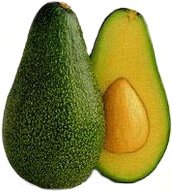
In cool temperate zones, Persea Americana is occasionally grown for interest. Plants are prone to leaf spotting, take up to seven years to fruit, and if grown from seed are likely to produce fruit of inferior quality. Grow in a well-drained, medium-fertility, loam-based mix, syringe daily in summer and water moderately when in growth, less in winter. Maintain a minimum temperature of 13-16ºC. Place the seed (pointed end up) with the top about 1cm above the surface of the potting mix, keep moist and shaded at 15-20ºC and move into full light following germination which may take up to 5-6 months. Alternatively, suspend seed by means of toothpicks just above water level in a jar or vase. Propagate also by greenwood cuttings in a closed case with bottom heat. Persea americanaAVOCADO PEAR; AGUACATE; ALLIGATOR PEAR; PALTA. Tree or shrub to 20m. Leaves 10-25cm, ovate-elliptic, acuminate or abruptly acute, sometimes near aristate, subcoriaceous to papery, dull dark-green above, paler beneath, appearing slightly glaucous. Panicles terminal, rufous; flowers green, finely downy. Fruit to 12cm, oblong-ovoid to pyriform, skin thick, leathery, glossy dark green, pale punctate, to dark purple-green, tuberculate, flesh lime-green to yellow, firm; smooth and oily seed ovoid, 4cm, solitary. C America, widely cultivated throughout warm temperate and tropical regions. Cultivated avocados will usually conform to one of three types, Guatemalan, W Indian, Mexican. Guatemalan and West Indian avocados fall within the circumscription of the typical variety americana. The Mexican avocados belong to variety drymifolia, with leaves aromatic, fruit small, narrow, thin-skinned. Guatemalan: mostly winter and spring ripening; rich-flavoured, high oil content. ‘Gwen’: fruits small to medium; long season. ‘Nabal’: medium to large, nearly round. ‘Pinkerton’: medium size, round to pear-shaped. ‘Reed’: medium to large, late summer. ‘Whitsell’: medium-sized, pear-shaped, spring-summer. ‘Wurtz’: small to medium, pear-shaped; tree small, suitable for containers and greenhouses. Mexican: Similar to Guatemalan but somewhat hardier; thin-skinned, high oil content. ‘Brogdon’: medium to large, pear-shaped. ‘Mexicola’: small, heat-resistant and cold-resistant; used as a parent. ‘Zutano’: small to medium, pear-shaped. West Indian: mostly summer and autumn ripening, low oil content. ‘Pollock’: very large (2-2.5kg). ‘Simmonds’: large. Guatemalan x Mexican: fairly high oil content; includes some of the most important commercial cultivars. ‘Bacon’: ovoid, crops well, some frost tolerance. ‘Ettinger’: medium size, pear-shaped, heavy cropper. ‘Fuerte’: medium to large, pear-shaped, possibly most popular cultivar worldwide. ‘Hass’: small to medium, pear-shaped to ovoid, purple to black skinned, heavy cropper. ‘Jim’: small to medium, good frost tolerance. ‘Lula’: medium size, pear-shaped, heavy cropper, good frost tolerance. ‘Sharwil’: medium size, oval, important Australian cultivar. Guatemalan x West Indian: important commercially in Florida; winter ripening. ‘Booth 8’: medium size, oblong, prolific. ‘Choquette’: large, oval, tree size suitable for gardens. ‘Hall’: large, pear-shaped. ‘Monroe’; large, heavy cropper. Others: Several very large-fruited cultivars are grown, mostly in Hawaii: ‘Fujikawa’, ‘Ota’ and ‘Yamagata’ are more or less pear-shaped, with high oil content; ‘Marcus Pumpkin’ has extremely large fruit, low oil content. A miniature cultivar, known as cocktail avocado, rather resembling a small gherkin in appearance, has recently been introduced. Z10.
|
Home
Grow Nuts
Grow Herbs
Grow Fruit
Cyberian Index
If you like this website and want one of your own contact
Cyberian All information correct at
time of publication and open to updates as necessary. No part of this website,
or its vectors, may be produced in any shape or form, using any type or design
of medium, system, equipment or otherwise without the prior written consensual
notice of the Cyberian. Any breach of these requirements will result in the
appropriate action. If in doubt, e-mail contact is recommended.
Some components of this website were obtained as open-source software and are
used in the same non-profit manner on this website.